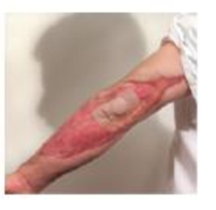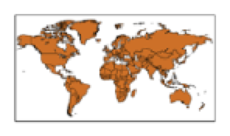
Necrotizing Fasciitis

Fever, chills, nausea, weakness, and general yuckiness. Carlos thought he was getting the flu. Further, he had pulled a cactus thorn from his arm the day before, and the tiny wound had swollen to a centimeter in diameter. It was red, extremely hot, and much more painful than such a puncture had a right to be. Everything was against him. He couldn’t afford to miss days at work, but he had no choice.
He shivered in bed with fever for the next two days and suffered more pain than he had ever experienced, certainly more than the time he broke his leg. Even more than passing a kidney stone. The red, purple, and black inflammation on his arm had grown to the size of a baseball. It was hard to the touch and excruciatingly painful. He decided it was time to call his brother to take him to the doctor. That decision saved his life.
Carlos’s blood pressure dropped severely, and he was unconscious by the time they arrived. The physician immediately admitted Carlos to the hospital, where the medical team raced to treat necrotizing fasciitis, commonly called “flesh-eating” disease. This reemerging disease is caused by group A Streptococcus, a serotype of Gram-positive bacteria also known as Streptococcus pyogenes. Group A strep invades through a break in the skin and travels along the fascia-the protective covering of muscles-producing toxins that destroy human tissues, affecting about 750 people each year in the United States.

By cutting away all the infected tissue; using high-pressure, pure oxygen to inhibit bacterial growth; and applying antimicrobial drugs to kill the bacterium, the doctors stabilized Carlos. After months of skin grafts and rehabilitation, he returned to work, grateful to be alive. (For more about necrotizing fasciitis, see pp.560-561.)
1. What color do cells of S. pyogenes appear after the
Want to see the full answer?
Check out a sample textbook solution
Chapter 4 Solutions
EBK MICROBIOLOGY:W/DISEASES BY BODY...-
- Answer number seven do what it says.arrow_forwardWhich of the following is the process that is "capable of destroying all forms of microbial life"? Question 37 options: Surgical scrub Sterilization Chemical removal Mechanical removalarrow_forwardAfter you feel comfortable with your counting method and identifying cells in the various stages of mitosis, use the four images below of whitefish blastula to count the cells in each stage until you reach 100 total cells, recording your data below in Data Table 1. (You may not need to use all four images. Stop counting when you reach 100 total cells.) After totaling the cells in each stage, calculate the percent of cells in each stage. (Divide total of stage by overall total of 100 and then multiply by 100 to obtain percentage.) Data Table 1Stage Totals PercentInterphase Mitosis: Prophase Metaphase Anaphase Telophase Cytokinesis Totals 100 100% To find the length of time whitefish blastula cells spend in each stage, multiply the percent (recorded as a decimal, in other words take the percent number and divide by 100) by 24 hours. (Example: If percent is 20%, then Time in Hours = .2 * 24 = 4.8) Record your data in Data…arrow_forward
- What are Clathrin coated vesicles and what is their function?arrow_forwardHow is a protein destined for the Endoplasmic Reticulum (ER), imported into the ER? Be concise.arrow_forwardFind out about the organisations and the movements aimed at the conservation of our natural resources. Eg Chipko movement and Greenpeace. Make a project report on such an organisation.arrow_forward
- What are biofertilizers and mention the significancearrow_forwardPCBs and River Otters: Otters in Washington State’s Green-Duwamish River have high levels of polychlorinated biphenyls (PCBs) in their livers. PCBs can bind to the estrogen receptors in animals and disrupt the endocrine system of these otters. The PCBs seem to increase the estrogen to androgen ratio, skewing the ratio toward too much estrogen. How would increased estrogen affect the river otter population? Based on your reading of the materials in this unit, what factors can affect fertility in humans? Explain how each of the factors affecting human fertility that you described can disrupt the human endocrine system to affect reproduction.arrow_forwardOther than oil and alcohol, are there other liquids you could compare to water (that are liquid at room temperature)? How is water unique compared to these other liquids? What follow-up experiment would you like to do, and how would you relate it to your life?arrow_forward
- Selection of Traits What adaptations do scavengers have for locating and feeding on prey? What adaptations do predators have for capturing and consuming prey?arrow_forwardCompetition Between Species What natural processes limit populations from growing too large? What are some resources organisms can compete over in their natural habitat?arrow_forwardSpecies Interactions Explain how predators, prey and scavengers interact. Explain whether predators and scavengers are necessary or beneficial for an ecosystem.arrow_forward
 Medical Terminology for Health Professions, Spira...Health & NutritionISBN:9781305634350Author:Ann Ehrlich, Carol L. Schroeder, Laura Ehrlich, Katrina A. SchroederPublisher:Cengage Learning
Medical Terminology for Health Professions, Spira...Health & NutritionISBN:9781305634350Author:Ann Ehrlich, Carol L. Schroeder, Laura Ehrlich, Katrina A. SchroederPublisher:Cengage Learning- Health Safety And Nutrition F/Young ChildHealth & NutritionISBN:9781305144767Author:MAROTZPublisher:Cengage





